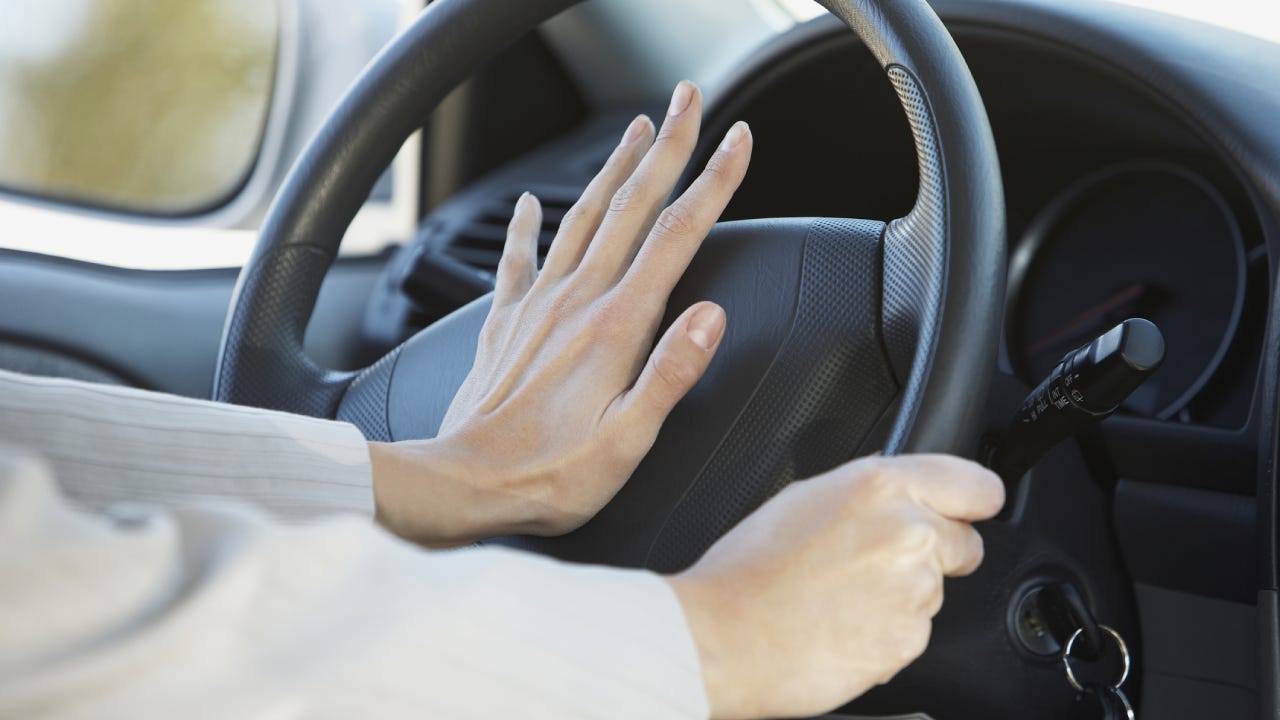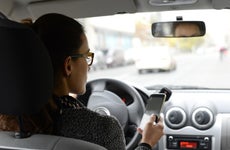Road rage statistics and facts in 2024

The Bankrate promise
At Bankrate, we strive to help you make smarter financial decisions. To help readers understand how insurance affects their finances, we have licensed insurance professionals on staff who have spent a combined 47 years in the auto, home and life insurance industries. While we adhere to strict , this post may contain references to products from our partners. Here's an explanation of . Our content is backed by Coverage.com, LLC, a licensed entity (NPN: 19966249). For more information, please see our .
The term “road rage” covers a broad category of the most dangerous driving habits, from cutting off other drivers in traffic to using a motor vehicle as a violent weapon. While extreme road rage is fairly rare, the aggressive driving habits that can escalate into a road rage incident are unfortunately common. Bankrate’s insurance editorial team looked into the latest data on violent anger on America’s roadways to help drivers navigate these dangerous situations.
What is road rage?
Road rage doesn’t have a single precise definition, but the term is usually used to describe an extreme form of aggressive driving in which drivers exhibit anger or violent behavior toward other drivers. While law enforcement doesn’t typically track road rage as a specific category of offense, various bodies offer different formulations of road rage’s meaning:
- American Automobile Association (AAA): A violent criminal act involving an intention to cause physical harm; an extreme form of aggressive driving. (AAA)
- National Highway Traffic Safety Association (NHTSA): An intentional assault by a driver or passenger with a motor vehicle or weapon that occurs on the roadway or is precipitated by an incident on the roadway. (NHTSA)
- New York State Department of Motor Vehicles: An angry, hostile state, which can increase into violent criminal actions or attempts of violent action that result from the operation of a motor vehicle. (NY DMV)
- Florida Department of Highway Safety and Motor Vehicles (FLHSMV): Violent or visibly angry behavior which can result in crashes or other incidents on roadways. (FLHSMV)
Road rage behaviors
It is important to note that aggressive driving and road rage are not the same, although aggressive driving contributes to road rage. Aggressive driving behaviors include common bad habits like speeding along with less-common behaviors like frequent lane changes, tailgating, cutting off other drivers and running red lights.
Road rage takes things one step further into more violent and potentially dangerous territory.
Aggressive Driving vs. Road Rage
| Aggressive Driving | Road Rage | |
|---|---|---|
| Basic definition | Deliberate, unsafe driving behavior that poses a risk to property or another | Extreme deliberate, angry driving that poses an immediate and significant risk to property or another |
| Common behaviors | Tailgating Speeding in heavy traffic Cutting off another driver Running red lights Weaving in and out traffic Frequently changing lanes |
Rude or inflammatory gestures Profanity Hitting, bumping, sideswiping or ramming another vehicle Use of headlights or brakes to intimidate or harass other drivers Forcing another car off the road |
Road rage statistics
- Over 17 percent of drivers regularly engage in aggressive driving behaviors such as speeding, running red lights, switching lanes quickly and driving closely behind other vehicles. (2022 AAA Traffic Safety Culture Index)
- Road rage incidents caused 481 shootings and 777 deaths between 2014 and 2023. (The Trace)
- Road rage and aggressive driving are caused by numerous factors, including traffic, running late and disregard for others and the law.
- Speeding — a form of aggressive driving — was responsible for 12,151 deaths on U.S. roadways in 2022. (NHTSA)
- 13.5 percent of drivers surveyed by AAA reported driving 15 mph over the freeway speed limit either regularly or “fairly often” in the past 30 days. (2022 AAA Traffic Safety Culture Index)
- Road rage deaths due to gun violence increased by more than 89 percent in 2020-2024, compared to the four years immediately before the COVID-19 pandemic. (The Trace)
How common is road rage?
Because definitions of road rage vary — and because this set of behaviors isn’t typically tracked by law enforcement — it’s hard to gauge exactly how common road rage is in 2024. Research by AAA in 2019 revealed that as many as 8 in 10 American drivers had engaged in aggressive driving behaviors like running red lights or flipping off another driver, but these habits don’t always escalate to road rage.
Likelihood of Aggressive Driving Among U.S. Drivers (AAA, 2019)
| Behavior | Percentage of drivers | Estimated total number of drivers |
|---|---|---|
| Aggressively switching lanes while close to another vehicle | 26% | 57 million |
| Honking or making rude gestures | 32% | 71 million |
| Driving 15 mph or more over the highway speed limit | 48% | 106 million |
| Running a red light | 31% | 68 million |
| Cutting in front of another vehicle | 22% | 49 million |
| Speeding to prevent another vehicle from passing you | 25% | 55 million |
| Tailgating to prevent another vehicle from merging in front of you | 34% | 75 million |
| Rushing to merge into traffic in front of another vehicle | 28% | 62 million |
Gun violence on roads
While complete data for the number of road rage cases per state is not available, we looked at The Trace’s study on road rage with a firearm. Statistics show that Texas, Florida and California lead the states in the number of road rage incidents involving guns, while New Mexico, Tennessee and Wisconsin see the highest rate of armed road rage incidents per 1 million residents.
- Road rage shootings increased by 449 percent between 2014 and 2023.
- 481 people were shot in 2023 due to road rage, down from 543 in 2022.
- A total of 3,095 people were shot in road rage incidents in the U.S. from 2014 to 2023.
- 777 of people shot in road rage incidents from 2024 to 2023 were killed.
- Houston, Milwaukee, San Antonio, Chicago and Memphis saw the most road rage shootings in the past decade.
Road rage cases by state (2047-2023)
| Rank | State | Number of road rage incidents involving a firearm |
|---|---|---|
| 1 | Texas | 741 |
| 2 | Florida | 4 |
| 3 | California | 179 |
| 4 | Tennessee | 166 |
| 5 | Wisconsin | 129 |
Road rage risk factors
What circumstances make road rage more likely? While incidents can happen anywhere at any time, there are certain factors that increase risk:
- Age: Research by AAA in 2022 found that drivers aged 19 to 24 were more likely than any other age group to have engaged in aggressive driving at least once in the past 30 days (30.3 percent), and to believe that people important to them would completely or somewhat approve of aggressive driving (7.4 percent).
- Gender: While drivers classified as Distracted and Aggressive by AAA are split evenly between men and women, 59 percent of AAA’s “Most Dangerous” driver category were men.
- Marital status: Both aggressive and dangerous drivers studied by AAA were more likely than other groups to have never been married, while the most dangerous driver category saw the highest rate of divorced, widowed or separated drivers.
- Month and day: Road rage incidents tend to be more likely in the summer months of July, August, September and even into October. They are also more likely toward the end of the week, based on the Auto Insurance Center’s analysis of Instagram posts using the #roadrage hashtag.
- Time of day: The same social media study found that the use of the hashtag #roadrage was much higher between 5 p.m. and 7 p.m., coinciding with peak commute hours.
- Type of car: Drivers with convertible tops up honked longer, sooner and more often than those with their convertible tops down, according to the NHTSA.
Certain behaviors surface again and again in fatal accidents. Not so coincidentally, many of these behaviors also coincide with road rage. The NHTSA reports that many of the major contributing factors to all motor vehicle crashes include aggressive behaviors:
- Speeding
- Driving under the influence (DUI)
- Following improperly
- Improper or erratic lane changing
- Illegal driving on the road shoulder, in a ditch, or on sidewalk or median
- Passing where prohibited
- Operating the vehicle in an erratic, reckless, careless or negligent manner or suddenly changing speeds
- Failure to yield right of way
- Failure to obey traffic signs, traffic control devices, or traffic officers, failure to observe safety zone traffic laws
- Failure to observe warnings or instructions on a vehicle displaying them
- Failure to signal
- Driving too fast for conditions or in excess of the posted speed limit
- Racing
Is your commute contributing to road rage?
Road rage tends to affect those who spend a lot of time on the road, which are often commuters. Traffic congestion is consistently cited as a leading factor in aggressive driving incidents.
Traffic and congestion continue to clog the roadways in the U.S., which is leading to hours spent in our vehicles for commuting. The INRIX Global Traffic Scorecard ranks the cities where commuters spend the most hours in their car and found the following U.S. cities are the worst:
| U.S. City | Number of hours spent in traffic per year |
|---|---|
| New York City | 102 |
| Chicago, IL | 104 |
| Philadelphia, PA | 90 |
| Boston, MA | 78 |
| Miami, FL | 66 |
The psychology behind road rage
As it turns out, there may be a psychological reason why road rage is on the rise. According to the American Psychological Association, road rage involves both environmental factors — such as road congestion — and emotional factors like unregulated anger. Road rage affects a driver by funneling anxiety, stress and anger from other aspects of life into hostile thinking behind the wheel.
Other observations include:
- Young men and those who abuse alcohol and drugs are more likely to experience road rage.
- Angry drivers take more risks on the road, including speeding 10-20 miles per hour over the speed limit, rapidly switching lanes, tailgating and running red lights.
- High-anger drivers are twice as likely to get into accidents.
How road rage impacts car insurance rates
Car insurance is designed to help provide financial protection for several incidents related to your car, but road rage is not one of them. Nearly every car insurance policy will exclude intentional acts. Allstate is one example, writing into its policies that it will not cover “loss caused intentionally by or at the direction of an insured person.”
That means if you are found guilty of road rage, your car insurance policy may not cover you. You would then be responsible for paying for any losses out-of-pocket. The other driver could also sue for extra damages.
If you are found guilty of road rage or aggressive driving, your insurance company could drop your coverage if you are found negligent. With car insurance required in most states, you may have to file for SR-22 insurance as a high-risk driver. An SR-22 form serves as proof that you have the minimum amount of coverage legally required. Not all insurance providers offer filing for this form and if they do, it usually costs a monthly fee. While the SR-22 form itself does not result in higher insurance rates, the incident causing the need for the SR-22 could lead to higher premiums.
At the very least, road rage behaviors are likely to increase car insurance rates due to increased insurable risk. However, the amount of the increase will depend on where you live as well as other rate factors in your risk profile.
How to prevent road rage
Road rage exists everywhere, but there are some things you can do when driving to help ensure that you are not its next victim.
When driving, be sure to abide by the rules of the road at all times and be courteous to your fellow drivers. You can avoid becoming a contributor to road rage by following these tips:
- Keep a safe distance between you and the other vehicles on the road.
- Always use your turn signals to communicate your intentions.
- Give room for other drivers to merge.
- Refrain from hand gestures and offensive or inflammatory language.
- Practice patience, regardless of whether you are at an intersection, in traffic or waiting for a parking spot.
- Refrain from using your high beams unless necessary to see.
As frustrating as U.S. roads can be, road rage isn’t worth the risks and dangers that it brings. The most important thing is to arrive at your destination safely, which patient driving can help achieve.
What to do in a road rage situation
If you are in a road rage situation, the best course of action is to remain calm and focus on getting to your destination safely. Do not engage with the other driver, do not return gestures or remarks made at you. Avoid eye contact, and be sure to keep seat belts buckled in case of unexpected braking. If someone is following you as the result of a road rage situation, avoid going to your home and try to pull into a police station, hospital, fire station or another heavily populated area.
When you safely reach your destination, call 911. If possible, provide a time, date, location, license plate, vehicle description and driver description. Write down or provide a fully detailed report of the incident, and prepare to appear in court if necessary.
Related Articles



Car crash statistics: Insight into the latest car crash fatality stats
